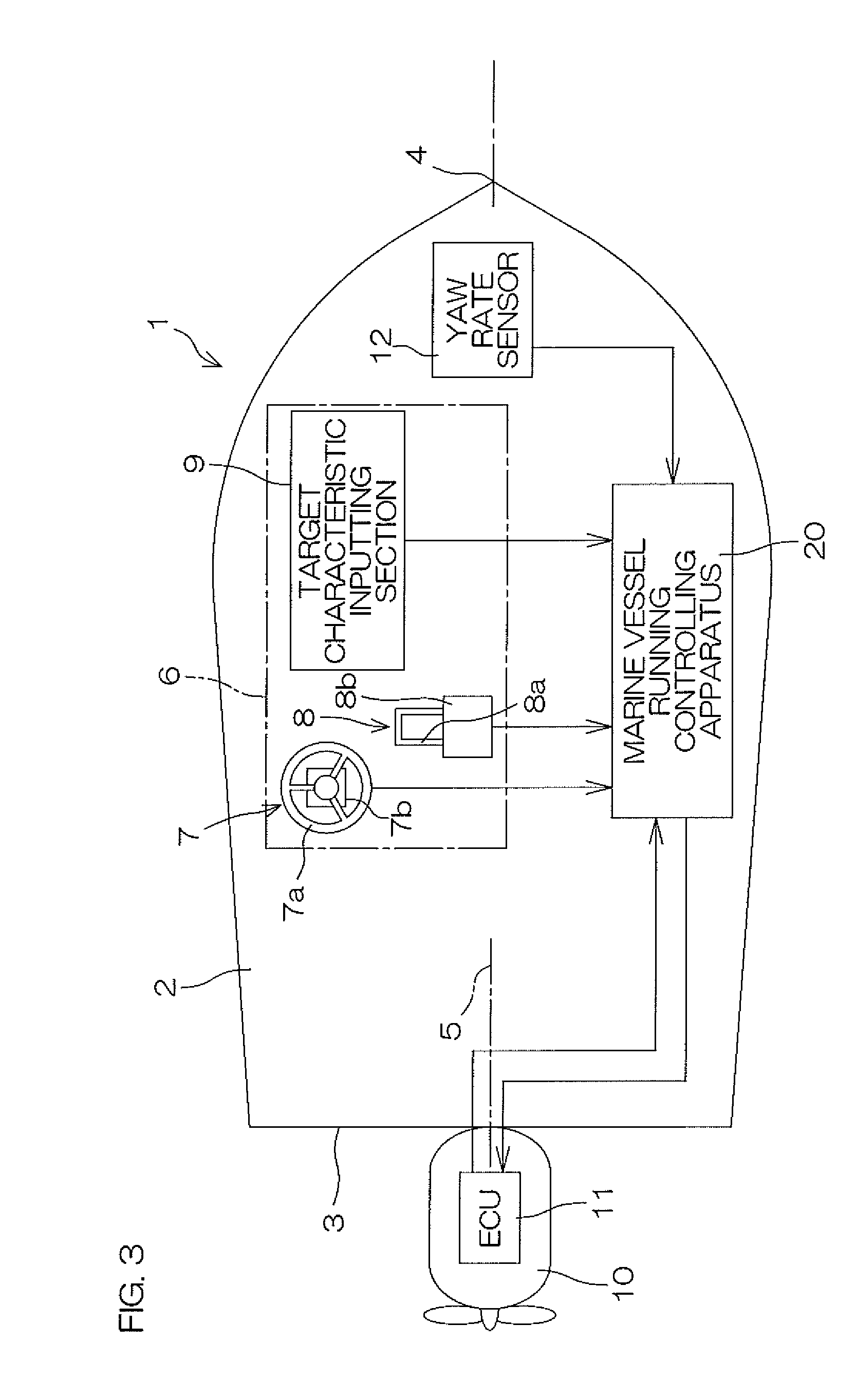Marine vessel running controlling apparatus, and marine vessel including the same
a controlling apparatus and a technology for marine vessels, applied in the direction of marine propulsion, vessel construction, instruments, etc., can solve the problems of inability to preliminarily provide the optimum characteristics of respective combinations, the relationship between the operation amount of the steering wheel and the steering angle cannot be changed according to the traveling speed of the hull, and the operator is more quickly turned than intended, so as to improve the maneuverability, the effect of reducing the unnatural or uncomfortable feeling
- Summary
- Abstract
- Description
- Claims
- Application Information
AI Technical Summary
Benefits of technology
Problems solved by technology
Method used
Image
Examples
first preferred embodiment
[0097]FIG. 3 is a schematic diagram for explaining the construction of a marine vessel 1 according to a first preferred embodiment of the present invention. The marine vessel 1 is preferably a relatively small-scale marine vessel, such as a cruiser or a boat. The marine vessel 1 includes a hull 2, and an outboard motor 10 (propulsive force generating unit) attached to a stern (transom) 3 of the hull 2. The outboard motor 10 is positioned on a center line 5 of the hull 2 extending through the stern 3 and a bow 4 of the hull 2. An electronic control unit 11 (hereinafter referred to as “outboard motor ECU 11”) is incorporated in the outboard motor 10.
[0098]A control console 6 for controlling the marine vessel 1 is provided on the hull 2. The control console 6 includes, for example, a steering operational section 7 for performing a steering control operation, a throttle operational section 8 for controlling the output of the outboard motor 10, and a target characteristic inputting secti...
second preferred embodiment
[0225]FIG. 28 is a block diagram for explaining an arrangement according to a second preferred embodiment of the present invention. When a required amount of data is accumulated in the storage section 60 by the data collecting section 64, the N-K characteristic table calculating module 63 calculates a new N-K characteristic table. In the preferred embodiment previously described, the new N-K characteristic table is preferably stored as it is in the N-K characteristic table storage section 63M, and used for the calculation of the N-S-R characteristic map. In this preferred embodiment, on the contrary, the N-K characteristic table to be used for the calculation of the N-S-R characteristic map preferably is conditionally updated by an N-K characteristic table updating module 100.
[0226]FIG. 29 is a flow chart for explaining the function of the N-K characteristic table updating module 100. When the new N-K characteristic table is calculated by the N-K characteristic table calculating mod...
third preferred embodiment
[0238]In a third preferred embodiment of the present invention, the gain K is preferably determined in a manner different from those in the first and second preferred embodiments. FIG. 31 is a flow chart for explaining the operation of the steering control section 28 according to the third preferred embodiment. In FIG. 31, steps corresponding to those shown in FIG. 9 will be indicated by the same step numbers. Reference will also be made to FIG. 7.
[0239]The data collecting section 64 collects time-series data sets of the engine speed, the steering angle and the yaw rate from the outboard motor ECU 11 for a predetermined period (Step S3) if the marine vessel 1 is in the constant speed traveling state (Step S2).
[0240]As shown in FIG. 32, if the steering angle is kept generally constant, the angular speed of the steering angle (hereinafter referred to as “steering angular speed”) has an absolute value not greater than a predetermined threshold defined at around 0. The steering angular ...
PUM
 Login to View More
Login to View More Abstract
Description
Claims
Application Information
 Login to View More
Login to View More - R&D
- Intellectual Property
- Life Sciences
- Materials
- Tech Scout
- Unparalleled Data Quality
- Higher Quality Content
- 60% Fewer Hallucinations
Browse by: Latest US Patents, China's latest patents, Technical Efficacy Thesaurus, Application Domain, Technology Topic, Popular Technical Reports.
© 2025 PatSnap. All rights reserved.Legal|Privacy policy|Modern Slavery Act Transparency Statement|Sitemap|About US| Contact US: help@patsnap.com



